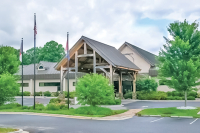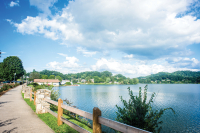Bird nerds unite
I learned, when I worked full-time for the Smoky Mountain News, that it helps if newspaper writers are thick-skinned. It doesn’t matter if you’re writing an op-ed piece, a feature or a news story. There will be someone somewhere who disagrees or doesn’t like it and may resort to calling you names.
But I was a little surprised last Wednesday (Jan. 11) when I opened a copy of the SMN to find that my friends, er, associates, there had decided I was a nerd. “Holiday Bird Nerd Diary” read the bold headline across my column regarding this year’s Balsam Christmas Bird Count.
“Main Entry: nerd - Pronunciation: ‘nerd’ Function: noun
Etymology: perhaps from nerd, a creature in the children’s book If I Ran the Zoo (1950) by Dr. Seuss (Theodor Geisel): an unstylish, unattractive, or socially inept person; especially: one slavishly devoted to intellectual or academic pursuits” from the Merriam Webster online dictionary.
I generally spend Monday evenings proofing the SMN, but because of an especially virulent stomach bug my 4-year-old passed along to Mommy and Daddy, I was otherwise occupied that Monday (Jan. 9).
I regret I did not proof that Monday. Not because of the gratuitous label my friends, er, colleagues at SMN decided to bestow upon me, but because I wasn’t able to correct an error in the column. The Lake Junaluska crew actually recorded 55 species rather than the 50 reported in the piece.
Related Items
Now, I can assure (I think) the other 21 participants in this year’s Balsam CBC and the other 80 million or so birders across the U.S. that my friends, er, acquaintances at SMN were not intent on disparaging them. It’s just that these are people who don’t know house finches from house sparrows and don’t understand our hobby.
So who are those bird nerds out there?
• Number of birders in United States in 2004: 85.2 million.
• Number of birders in United States in 1983: 21 million.
• Percentage who are female: 56
• Percentage who are ages 16-24: 16
• Percentage who are ages 25-39: 24
• Percentage who are ages 40-59: 37
• Percentage who are older than 60: 23
• Percentage who hold college degrees: 28
• Percentage who earn more than $50,000 a year: 47
My source for these numbers is the U.S. Department of Agriculture Forest Service’s National Survey on Recreation and Environment, which was completed in 2000. The total number of birders is from a 2004 updated survey by the Forest Service.
And what are some of the economic and scientific impacts bird nerds have?
Economics:
• Each year, nongame wildlife appreciation in the United States generates a total economic return of $20 billion (USDI Survey, 1993). The largest part is contributed by bird enthusiasts.
• A total of $3 billion was spent in 1991 on equipment and supplies for nongame wildlife appreciation activities. (USDI Survey, 1993)
• Annually, more than $1 billion is spent on birdseed, feeders, baths, and nesting boxes. (USDI Survey, 1993)
• The average birder annually spends more than $350 on travel and paraphernalia related to birdwatching. Committed birders spend much more, on average. Active birders annually spend about $2,000 on birdwatching, with half that amount on travel, i.e. avitourism. (Wiedner and Kerlinger, 1990)
• In 1991, 24 million Americans took trips for the express purpose of viewing and photographing wild birds. They spent $2.5 billion on trip-related expenses, including $1.5 billion on food and lodging. (USDI Survey, 1993)
• Cape May, New Jersey: More than 100,000 birders visit this area annually, providing a cumulative impact of nearly $10 million. (Kerlinger and Wiedner, 1991).
• High Island, Texas: In 1992, more than 6,000 birders visitors this small Gulf Coast town. They spent $2.5 million directly in the community, and generated a total regional economic impact of about $6 million. (Eubanks, Kerlinger, and Payne, 1993).
• Chincoteague National Wildlife Refuge, Virginia: The economic impact to the local community by wildlife viewers in 1994 was nearly $10 million. (Kerlinger, 1994).
• Hawk Mountain Sanctuary, Pennsylvania: More than 50,000 visitors each year contribute more than $4 million to the local economy. (Kerlinger and Brett, 1990).
Source: International Migratory Bird Day Organizer’s Packet, Sharing Your Passion for Birds.
Science:
• Using data from Birds in Forested Landscapes, the Lab of Ornithology published A Land Manager’s Guide to Improving Habitat for Scarlet Tanagers and Other Forest-interior Birds in 1999.
• Acid rain has had a strong negative effect on the likelihood that wood thrushes attempt to breed in some regions. The data on wood thrushes were based on the Birds in Forested Landscapes project and the Breeding Bird Survey (Proceedings of the National Academy of Sciences, 2002, 99:11235–11240).
• Tree swallows have begun laying eggs on average about 9 days earlier over the past 30 years, apparently in response to climate change. Researchers used 3,450 records from the Cornell Lab of Ornithology’s North American Nest Record Card Program (1970 to 1992) and 5 nest record programs in Canada. (Proceedings of the Royal Society of London Series B, 1999, 266: 2487-2490)
• Some 180 million fewer house finches exist today than would have if they had never been exposed to the house finch eye disease. The disease appears to be regulating the numbers of house finches in some regions. The findings were based on data collected by participants of the House Finch Disease Survey and Audubon’s Christmas BirdCount (Proceedings of the National Academy of Sciences, 2000, 97:5303–5306). Data from Cornell Lab of Ornithology.
I also learned, while working full time at SMN that it’s the computer geeks and desk jockeys who have the last say and since the geeks and jockeys have “outed” me I have only one recourse. I’ll just go to http://www.whogivesashirt.ca/WGASBN.html and order one of the above T-shirts. Being a bird nerd isn’t so bad.









